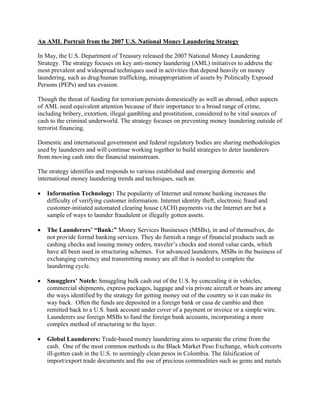
National Money Laundering Strategy 2007 A Review
- 1. An AML Portrait from the 2007 U.S. National Money Laundering Strategy In May, the U.S. Department of Treasury released the 2007 National Money Laundering Strategy. The strategy focuses on key anti-money laundering (AML) initiatives to address the most prevalent and widespread techniques used in activities that depend heavily on money laundering, such as drug/human trafficking, misappropriation of assets by Politically Exposed Persons (PEPs) and tax evasion. Though the threat of funding for terrorism persists domestically as well as abroad, other aspects of AML need equivalent attention because of their importance to a broad range of crime, including bribery, extortion, illegal gambling and prostitution, considered to be vital sources of cash to the criminal underworld. The strategy focuses on preventing money laundering outside of terrorist financing. Domestic and international government and federal regulatory bodies are sharing methodologies used by launderers and will continue working together to build strategies to deter launderers from moving cash into the financial mainstream. The strategy identifies and responds to various established and emerging domestic and international money laundering trends and techniques, such as: • Information Technology: The popularity of Internet and remote banking increases the difficulty of verifying customer information. Internet identity theft, electronic fraud and customer-initiated automated clearing house (ACH) payments via the Internet are but a sample of ways to launder fraudulent or illegally gotten assets. • The Launderers’ “Bank:” Money Services Businesses (MSBs), in and of themselves, do not provide formal banking services. They do furnish a range of financial products such as cashing checks and issuing money orders, traveler’s checks and stored value cards, which have all been used in structuring schemes. For advanced launderers, MSBs in the business of exchanging currency and transmitting money are all that is needed to complete the laundering cycle. • Smugglers’ Notch: Smuggling bulk cash out of the U.S. by concealing it in vehicles, commercial shipments, express packages, luggage and via private aircraft or boats are among the ways identified by the strategy for getting money out of the country so it can make its way back. Often the funds are deposited in a foreign bank or casa de cambio and then remitted back to a U.S. bank account under cover of a payment or invoice or a simple wire. Launderers use foreign MSBs to fund the foreign bank accounts, incorporating a more complex method of structuring to the layer. • Global Launderers: Trade-based money laundering aims to separate the crime from the cash. One of the most common methods is the Black Market Peso Exchange, which converts ill-gotten cash in the U.S. to seemingly clean pesos in Colombia. The falsification of import/export trade documents and the use of precious commodities such as gems and metals
- 2. in lieu of cash to transfer value across multiple borders are other methods identified by the strategy. • Six Degrees of Separation: Any jurisdiction with lax regulatory and supervisory administration or strict secrecy laws is a tempting venue for individuals who seek to hide their identity. By hidden control, launderers are able to incorporate various methods of structuring to layer and ultimately clean their true source of wealth via legal entities (i.e. Trusts, LLCs). • Three-Card Monte on the Reservation: The casino industry in general has been a method of cleaning cash because it offers credit and deposit accounts and other MSB-type transactions. Exchanging chips for cash is a common and easy way to start the laundering process. With the growth of the Native American casinos, Indian reservation gambling halls have become a bigger money generator than Vegas or Atlantic City. Though at the moment casinos on Native American soil typically do not offer deposit or credit accounts, the washing of cash for chips and back again is a launderers’ playground. • Full Coverage: The insurance industry now offers investment services and financial products that can be easily flipped to wash dirty money. Term life and annuity products are the primary vehicles favored by launderers either through collusion with an intermediary agent or through falsification of their applications. • Paying their Dues: The Treasury and Justice departments’ Asset Forfeiture Funds help to support AML task forces and law enforcement agencies’ innovation and training. In 2004 approximately $390.5 billion was recovered in forfeited cash and property, of which some $264 million or 0.66 percent was retained for use by law enforcement. For now, the financial world can breathe a sigh of relief knowing that the government and regulatory agencies recognize its need for enhanced AML tools. While the industry awaits more specifics from regulatory and enforcement agencies, for now Suspicious Activity Reports (SARs) continue to serve as an invaluable way for financial institutions to recognize patterns and provide value-added data for various agencies monitoring the flow of illegal funds. For the full article, go to: http://www.treas.gov/press/releases/docs/nmls.pdf Vicky Lee,CAMS Madison Consulting Group, New Jersey, U.S.A, vlee@madisoncg.com